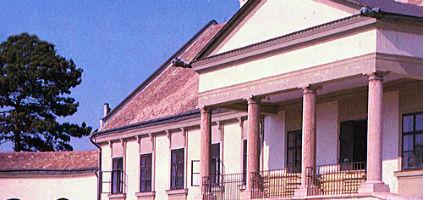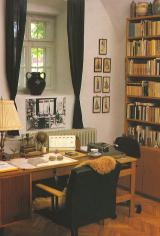2024. April 24. Wednesday
Erzsebet Galgoczi Memorial Room - Győr
 |
Address: 9012, Győr Kisdobos út 1-5.
Phone number: (96) 556-207
E-mail: emlekszoba@bezeredj-kastely.hu
Opening hours: Tue-Fri 14-18
(On prior notice: beyond the opening hours as well) |
An exhibition opened on 17 May 1991, on the second anniversary of her death, in memoriam of the Kossuth Prize winner artist, Galgóczi Erzsébet, in the framework of the International Days of Museums. The memorial room is furnished with the belongings of the writer. The family of Galgóczi Erzsébet and the town where she lived, Ménfőcsanak, donated the material.
Galgóczi Erzsébet was born in Ménfő on 27 August 1930 and died on 20 May 1989 in Ménfőcsanak. She attended secondary school in Győr from where she graduated in 1949. She worked as a turner in the carriage factory of Győr. During 1951-1955 she studied at the Drama Department of the Collage of Theatre. She worked as a journalist for the magazines 'Hungarian Youth' and 'Educated People' and was a freelancer writer from January 1957. She received the Kossuth Prize for her work in literature in 1978, the József Attila Prize thrice (1962, 1969, 1976) and the SZOT Prize.
The memorial room is located in the Bezerédj Castle. Esterházy Pál built the castle and the farming building around it in the 17th century. The castle is dated back to around 1780 while the gate was made in 1804. The chapel is from the 17-18th century. The Bezerédj family acquired the estate in 1917. Ever since, the castle is named after the family.
The buildings where the Cultural Center, library and memorial room are located now were reconstructed in 1988. The reconstruction of the chapel ended in 1991. Galgóczi Erzsébet wrote the following of teh castle: 'It is best to call the castle the home of lords. The Baroque building with Classicist facade has fourteen rooms. The border of the coach drive and the poles are made of red marble. Under the drive there is a door to the cellar. This and the wrought iron windows of the wings suggest harmony and dignity.'
The memorial room is located in the wing in a spacey room with an arched entrance. On one side rooms from the peasant room of the writer are shown, which are to complement the aesthetic needs of a person - said once Galgóczi Erzsébet. Her study is located on the other side of the ward. Berta Bulcsú saw it the following: 'The study that was also the bedroom was puritan. Bookshelves cover the walls... A large desk and chair are in front of the window. A calendar, typewriter, manuscripts, green plants, pencils and a little doll are on the table. A large sofa is in front of the bookshelf and an old radio on the bottom shelf. Drawings cover the walls by Szilvássy Margit and Mamuzych Magda of the mother of Galgóczi Erzsébet. (Bertha B., 1977.)
In the middle, in the wards, the visitors can see her works. Documents, manuscripts, proofs of her care for her objects, medals focusing on her literary work.
We show her career via her writings, criticism and quotations. The arts historian Pomogáts Béla wrote the script of the exhibition. The historian of the Xantus János Museum, Szabó Péter, organized the exhibition based on the script.
(Except from the TKM Notebooks entitled Galgóczi Erzsébet Memorial Room)
Galgóczi Erzsébet was born in Ménfő on 27 August 1930 and died on 20 May 1989 in Ménfőcsanak. She attended secondary school in Győr from where she graduated in 1949. She worked as a turner in the carriage factory of Győr. During 1951-1955 she studied at the Drama Department of the Collage of Theatre. She worked as a journalist for the magazines 'Hungarian Youth' and 'Educated People' and was a freelancer writer from January 1957. She received the Kossuth Prize for her work in literature in 1978, the József Attila Prize thrice (1962, 1969, 1976) and the SZOT Prize.
The memorial room is located in the Bezerédj Castle. Esterházy Pál built the castle and the farming building around it in the 17th century. The castle is dated back to around 1780 while the gate was made in 1804. The chapel is from the 17-18th century. The Bezerédj family acquired the estate in 1917. Ever since, the castle is named after the family.
The buildings where the Cultural Center, library and memorial room are located now were reconstructed in 1988. The reconstruction of the chapel ended in 1991. Galgóczi Erzsébet wrote the following of teh castle: 'It is best to call the castle the home of lords. The Baroque building with Classicist facade has fourteen rooms. The border of the coach drive and the poles are made of red marble. Under the drive there is a door to the cellar. This and the wrought iron windows of the wings suggest harmony and dignity.'
The memorial room is located in the wing in a spacey room with an arched entrance. On one side rooms from the peasant room of the writer are shown, which are to complement the aesthetic needs of a person - said once Galgóczi Erzsébet. Her study is located on the other side of the ward. Berta Bulcsú saw it the following: 'The study that was also the bedroom was puritan. Bookshelves cover the walls... A large desk and chair are in front of the window. A calendar, typewriter, manuscripts, green plants, pencils and a little doll are on the table. A large sofa is in front of the bookshelf and an old radio on the bottom shelf. Drawings cover the walls by Szilvássy Margit and Mamuzych Magda of the mother of Galgóczi Erzsébet. (Bertha B., 1977.)
In the middle, in the wards, the visitors can see her works. Documents, manuscripts, proofs of her care for her objects, medals focusing on her literary work.
We show her career via her writings, criticism and quotations. The arts historian Pomogáts Béla wrote the script of the exhibition. The historian of the Xantus János Museum, Szabó Péter, organized the exhibition based on the script.
(Except from the TKM Notebooks entitled Galgóczi Erzsébet Memorial Room)
